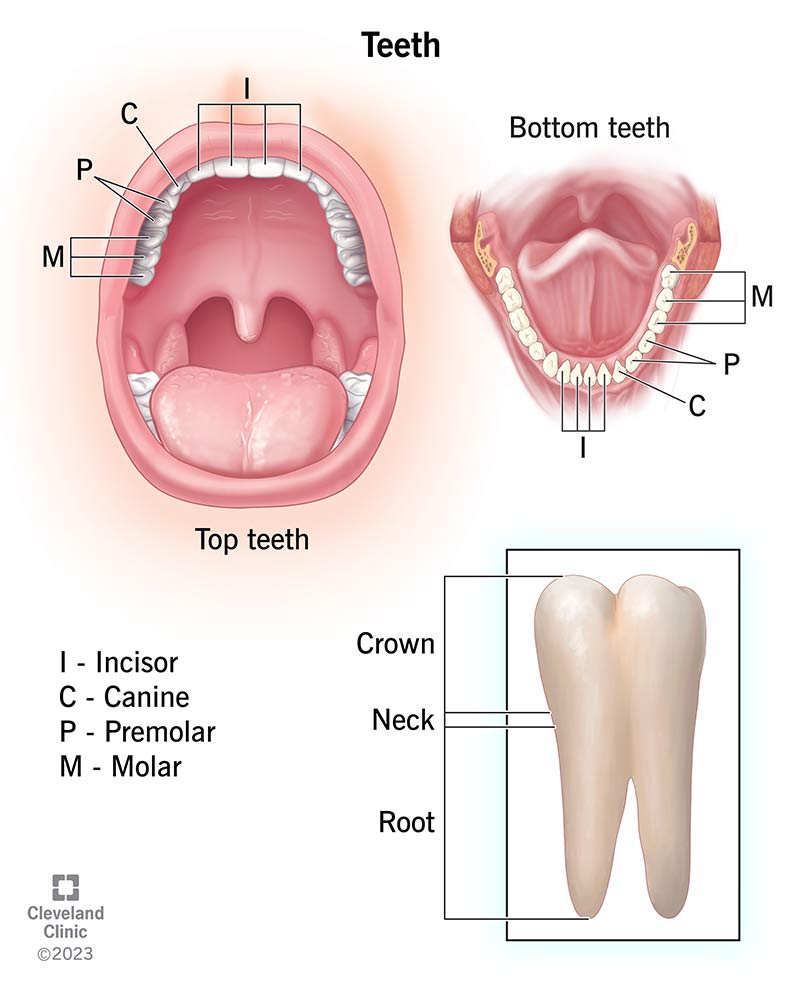Your teeth are part of your digestive system. They break down foods by crushing or cutting them before you swallow. Most humans have 32 teeth, although some have more and some have fewer. Enamel (the protective outer layer of your teeth) is the hardest substance in the human body.
Advertisement
Cleveland Clinic is a non-profit academic medical center. Advertising on our site helps support our mission. We do not endorse non-Cleveland Clinic products or services. Policy

Your teeth play a big role in digestion. They cut and crush foods, making them easier to swallow.
Advertisement
Cleveland Clinic is a non-profit academic medical center. Advertising on our site helps support our mission. We do not endorse non-Cleveland Clinic products or services. Policy
Though they look more like bones, teeth are actually ectodermal organs. Other ectodermal organs include your hair, skin and sweat glands.
Most adults have 32 permanent teeth. But some people are born with missing teeth (hypodontia), and some people have extra teeth (hyperdontia).
Most children have 20 primary teeth that grow in (erupt) between the ages of 4 months old and 6 years old. These are baby teeth that’ll eventually fall out and make room for permanent adult teeth.
We have different types of teeth, and each type serves an important purpose. There are four types of permanent teeth in humans:
Your incisors are the most visible teeth in your mouth. Most people have four incisors on the upper jaw and four on the lower. These include your front two teeth and the teeth on either side of them.
Each incisor has a single narrow edge, which helps cut into food when you bite.
Canine teeth get their name because they resemble a dog’s fangs. They’re pointier than other types of teeth. Most people have four canine teeth — one in each quadrant (upper right, upper left, lower right, lower left).
Canine teeth help you tear into foods like meat and crunchy vegetables. Sometimes, people call canines “eye teeth” because of their position directly under your eyes.
Advertisement
Also called bicuspids, premolars sit between your canines and your molars (the teeth in the back of your mouth).
Premolar teeth have features of both canines and molars. They help you tear, crush and grind food into smaller pieces.
Your molar teeth are in the very back of your mouth. Most of your chewing — about 90% — takes place here. Most adults have 12 molar teeth — three in each quadrant.
Molar teeth include wisdom teeth (third molars). So, if you’ve had your wisdom teeth removed, or if you were born without them, then you probably have eight molars altogether.
Because molars are your main chewing teeth, they’re good for crushing and grinding up your food.
A tooth consists of two main structures:
Your teeth have four main layers, including:
No. Although teeth resemble bones, they’re actually quite different. Bones can regenerate (repair) when they’re broken. Teeth can’t. Unlike bones, your teeth don’t contain marrow.
Dentists and other healthcare providers use numbering systems to label teeth. There are a few different numbering systems, but the one most providers in the United States use is the Universal Numbering System.
The Universal Numbering System assigns a number from 1 to 32 to adult teeth, beginning with your upper-right third molar. You count toward your two front teeth and then to the left side. Once you reach #16 (your upper-left third molar), you drop down and begin with #17 (your lower-left third molar). Then, counting across your lower teeth, you end up at #32 (your lower-right third molar).
Advertisement
Dentists still assign numbers to any missing teeth. By doing this, they can create an accurate tooth chart to keep in your records.
Dentists also use the Universal Numbering System to label primary (baby) teeth. It works in a similar way, but instead of numbers, you use letters. For example, baby teeth are labeled A to T, beginning with the upper-right molar. Counting all the way across the upper teeth, you reach #J (the upper-left molar). Next, you drop down to #K on the lower left, then count all the way across the lower teeth until you reach #T (the lower-right molar).
Tooth decay is one of the most common dental issues. In fact, over 90% of adults in the U.S. over 40 have had at least one cavity. Cavities can form when bacteria eat through the hard, outer layer of your enamel. Once the dentin underneath loses this protective layer, the bacteria continue to erode your tooth.
Other common issues that can affect your teeth include:
Advertisement
Some of the most common complaints among people with dental issues include:
Some of the most common dental treatments include:
Proper oral hygiene is the key to healthy teeth and gums. Here are some general guidelines:
Sometimes, people are born without certain teeth. Others may lose teeth due to cavities, gum disease or trauma.
Whether you need to replace the tooth depends on a few factors, including the location of the missing tooth and your personal oral health goals.
Today, there are many teeth replacement options available, including dental implants, dental bridges and dentures.
Each tooth has nerves and blood vessels that supply nutrients. When an infection reaches the tooth pulp, the nerves in the center of the tooth can detect pain.
Advertisement
Your teeth are an essential part of your digestive system. They help you bite, tear and grind food up before swallowing it. To keep your teeth healthy, visit your dentist regularly and practice good oral hygiene at home. With proper care and maintenance, your teeth can serve you well for a lifetime.
Dentistry plays an important role in oral health. Cleveland Clinic’s experts can design a personalized plan that will keep you smiling for the long haul.

Last reviewed on 01/26/2023.
Learn more about the Health Library and our editorial process.